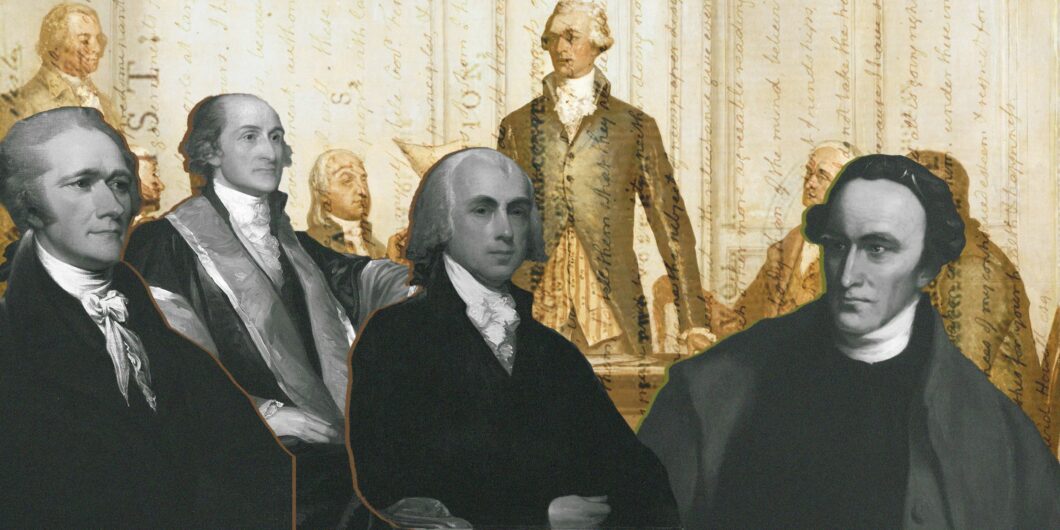Putting Publius in Perspective
I begin by expressing my gratitude both to Law & Liberty for sponsoring this forum, and to Steve Ealy, Nathan Coleman, and Matt Schoenbachler for their excellent essays. In this final response, I will endeavor to give their essays the respect and attention they deserve. Since Coleman’s essay is the most challenging, I have devoted the most attention to his very interesting and important ideas.
Steve Ealy’s smoothly written essay raises several important points. Perhaps one of the most incisive has to do with Publius’ perception of human nature. Ealy says in essence that, yes, Publius rightly points our attention to considerations of human nature, and although Publius noted the complexity of human nature, he may not have perceived, or anticipated, just how complex human beings are. He suggests that social media has provoked and exposed a level of “depravity,” to use Publius’s word, that the Founders may not have anticipated.
To illustrate Ealy’s point, one need only look at the level of gratuitous and unprovoked malice and vitriol on social media surrounding the June 18, 2023 tragedy of the Titan submersible. Even those who have become jaded by social media are disturbed. Unfortunately, social media means “never having to say you’re sorry”—it is a consequence-free environment. It has taken us to new depths—no pun intended—notwithstanding all of the advantages it has wrought. If Publius were transported to the twentieth century, would his view of humanity be confirmed, or would he be shocked? The more critical question is: Would he still believe that men and women are capable of self-government?
Ealy is right to note that Publius seems to do little to anticipate the emergence of formal political parties. Before concluding that discussion, attention should be given to Essay #10, and also to “Essay #10 Redux” in the latter half of #51 where Publius reiterates the thesis of #10. In addition, one should look to those passages (especially #60, #61, and #63) in which, in the course of explaining the Senate, Publius offers more incidental commentary on the value of diverse views in a large republic. Furthermore, the word “party” occurs numerous times in The Federalist, usually pejoratively. While these references fall short of addressing formal political parties, there may be more material than we usually recognize that might be extrapolated to apply to political parties. Matt Schoenbachler goes so far as to equate “factions” with modern political parties. This may take the argument further than many would, but it does suggest that The Federalist may have more to say about the modern political party system than is often understood.
Granted, our constitutional separation of powers has not always worked as it should, but even when it has not, Publius’ scheme provides a diagnostic tool.
Among other things, Publius argues in #60 that the election of senators by state legislatures, and the election of the president by the electoral college, would mitigate “certain turbulent and factious seasons” by protecting the government from misguided popular opinion. If that is true, we have no one to blame but ourselves for changing those mechanisms by means of the 17th and 22nd Amendments. It also may be helpful to remember that in Essay #10, Publius’ great preoccupation is with a majority faction that does not respect property rights, and that concern might provide a rubric by which the modern political party might be judged.
Nathan Coleman brings a great deal of erudition to this forum, and he should be applauded for doing so. It concerns him that the Federalist Papers are treated as political philosophy, as Steve Ealy, Matt Schoenbachler, and I advocate. He complains that other essential writings have been neglected because too much attention has been given to the work of Publius. He is concerned, that “Modern America . . . understands, teaches” and uses The Federalist “wrongly.” To be sure, any serious student of American Political Thought should pursue Coleman’s recommended sources to supplement their reading of the Federalist essays. I provide here a hyperlink for several of his recommendations: They include John Jay’s “Address to the People of New York,” John Dickinson’s “Fabius Essays,” and James Wilson’s “State House Address.” This is sage advice indeed, as these sources at least serve as supplements to The Federalist.
Coleman is passionate about his thesis, and even distressed. He feels it necessary not only to suggest alternate readings but also to highlight the instances in which Publius is “wrong,” and this leads him into a few rhetorical lapses. One of the most egregious of those is his use of an “argumenum ad absurdum” in which he accuses advocates of the Federalist essays of using that material as a “decoder ring that cracks the mysteries of constitutional meaning.” Such a caricature is unhelpful. Coleman also, in several instances, criticizes a“straw man” of his own making, especially in the several instances in which he claims that those who rely on the Federalist Papers do so to the exclusion of other sources. While at times this is undoubtedly true, at other times it certainly is not.
Coleman explains that the shortcomings of the essays are a consequence of the “Publius as Political Theorist treatment.” For example, the use of the papers in Constitutional interpretation is, in most cases, little more than jurisprudential “window dressing.” If the Supreme Court were to follow Coleman’s counsel, the justices would arrive at “wildly different conclusions” in their jurisprudence. This is a bold claim and it might even be true. Since it would take a great deal of space and time to defend this thesis, however, and out of respect for the reader, a more cautious claim might be better than such a sweeping assertion.
Coleman also announces that it is “readily apparent” that the mechanism of “ambition” that Publius introduces in #51 “has not worked.” After almost two hundred and fifty years of political life under the Constitution of 1787, that premise is a lot to presume. Many may not find this conclusion “apparent,” much less “readily apparent.”
Granted, our constitutional separation of powers has not always worked as it should, but even when it has not, Publius’ scheme provides a diagnostic tool. For example, some might argue that the growth of presidential power in recent decades has been precisely because an “un-ambitious” Congress has relinquished its constitutional duties and power to the chief executive and to administrative agencies.
Coleman seems less concerned, moreover, about judicial independence than judicial overreach. Many would agree with him. He characterizes the Supreme Court as a “hardened fortress,” and in so doing employs the phrase from Federalist #68, often taken ironically, that among the three branches of government the Supreme Court will be the “least dangerous to the rights of our Constitution.”
But Publius’ claim should not be dismissed out of hand: Whether it is true or not seems to depend on whose constitutional ox the Court may be goring. Currently, many would agree that compared to the legislative and executive branches, the US Supreme Court is the “least dangerous” to our rights. Indeed, the Supreme Court is currently under siege for protecting our constitutional rights and that, once again, warns us of the importance of judicial independence
Coleman rightly turns our attention to the “historical relevance” of the essays, but in doing so feels he must discount their “contemporary relevance.” But could this be a false dichotomy?
Aside from all the ways in which Publius is “wrong,” Coleman believes the essays were “too hurried” to be taken seriously as works of political philosophy. In this, Coleman seems not to follow his own counsel. He is more aware than most that the ideas in The Federalist had been percolating for months if not years, and that they were at times discussed among the principal authors of the Constitution. Many of those ideas, moreover, were debated at the Constitutional Convention. In other words, looking at the production of the essays in a historical context would suggest that though the final draft of these ideas was published posthaste, they had been developing for a long time, their rapid-fire publication notwithstanding. Schoenbachler asserts that The Federalist is valuable political philosophy in spite of the pace at which they were issued.
Coleman also asserts that the essays fall short of political theory because they were written to win an argument. Used as they were to achieve an immediate political objective, he argues that they cannot be serious political philosophy such as we see in Locke, Hobbes, and even John C. Calhoun. But both Locke and Hobbes wrote in response to prevailing concerns even if their work was not the product of an immediate debate. Locke’s Second Treatise of Government is written, in part, to justify opposition to King Charles II and to legitimize the revolution of King William. The turmoil and terror of the English Civil Wars prompted Hobbes to write Leviathan. Those writings may fall short of a polemic, but most political philosophy is written against other ideas. Furthermore, offering John C. Calhoun’s Disquisition on Government as polemic-free political philosophy, is, in a word, curious.
Reading Coleman’s concerns reminds me of a conversation I had with several other professional historians years ago who argued that the Declaration of Independence has scant enduring value because it was little more than an appeal for diplomatic recognition. Coleman rightly turns our attention to the “historical relevance” of the essays, but in doing so feels he must discount their “contemporary relevance.” But could this be a false dichotomy? Might both approaches be valuable and mutually supportive? Schoenbachler seems to tie it all together nicely by recognizing that the essays have a “dual” character: one with historical relevance, and the other with contemporary relevance.


